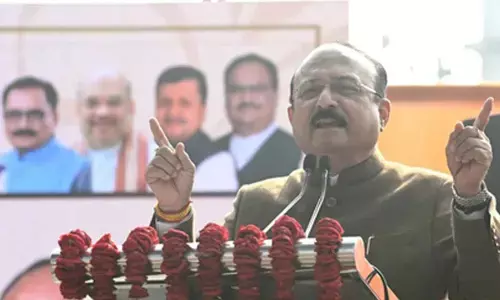India needs to drastically reform higher education in rapidly digitising world: Study

As India gets ready to celebrating its 71st Independence Day, concerns over honing its human capital come to the fore These must be addressed if the nation is to seize the opportunity offered by a demographic dividend for sustainable and inclusive digital growth
As India gets ready to celebrating its 71st Independence Day, concerns over honing its human capital come to the fore. These must be addressed if the nation is to seize the opportunity offered by a demographic dividend for sustainable and inclusive digital growth.
The growing working population, which is expected to increase by 1.3 million every month between now and 2025 (World Bank, 2018) demands a focus on higher education and skilling to create a pool of human capital in the ongoing digital revolution and take India on a higher growth trajectory.
While India already lags behind its peers in terms of employment generation owing to various socio-economic reasons, growing digitalisation can further accentuate the frictions in the job market if the country doesn't align the skills of its rapidly growing workforce to the demands of the new digital economy. It is, thus, essential to adapt to the new technology to tap the full potential of digital disruption and reduce inequality in the society.
This could be achieved in part by transforming the higher education system in India in a way that it enables students to prepare for the challenges of future jobs. This, however, requires an understanding of the way innovations are going to impact the country's labour market. There seems to be a likely increase in the demand for the high skilled workers who use non-routine cognitive and ICT skills and the low skilled workers who use non-routine manual skills, while the mid-level skilled workers who are in their routine occupations are more likely to experience a decline in demand for their skills because of the automation of the repetitive tasks.
A 2017 OECD study, "Future of Works and Skills", points out that employment in high skilled occupations in India experienced a 6.3 percentage point increase over 2002- 2014, while employment in medium skilled routine occupations declined 5.3 percentage points over this period.
Sectoral analysis of the Indian economy reveals that the manufacturing sector has a high potential for automation, with an estimate of 69 percent of the tasks that could be automated in organised manufacturing in India (World Bank Group Foresight Report, 2016).
The automobile sector is expected to buy 60 per cent of all industrial robots sold in India (ET Auto, 2015), which could be used for doing a large number of routine tasks such as welding, polishing and painting in the manufacturing plants, leading to a consequent decline in such jobs.
Further, looking at the services sector, e-commerce provides an example of India's industry where technology-enabled innovations, such as digital payments, hyper-local logistics, analytics driven customer engagements and digital advertisements are expected to support the growth of the sector. While the sector is set to grow from $38.5 billion in 2017 to $200 billion by 2026 and, consequently, expected to generate employment in e-commerce and the allied industries such as logistics, transport and warehousing, there is a greater likelihood of displacement of small to medium retail enterprises and shop floor salespersons they have, because of the increasing demand for the automation skills in the industry.
The IT sector has been undergoing a huge technology transformation and has seen tremendous growth over the last 20 years. Its contribution to India's GDP rose to approximately 9.5 percent in 2015 from 1.2 percent in 1998. However, the sector is expected to experience a 14 percent decline in its workforce by 2021 on account of application of machine learning and Cloud computing technologies which will automate the routine and backend tasks.
Thus, IT sector workers need to upskill themselves on the SMAC (Social, Mobility, Analytics and Cloud) technologies to overcome the labour market frictions arising out of the digital transformation. The SMAC market is expected to grow to $225 billion by 2020 and create employment opportunities in related capabilities.
The impact of automation technologies has also been felt in the financial sector, where there is already an extensive use of chatbots and internet banking at the customer services end. While there will be some job displacements for the digital transactions which are non-risky in nature, there will always be a requirement for human intervention when it comes to risky transactions and investing money. In fact, digital finance is expected to create 21 million new jobs by 2025.
A review of the future of work in India across various sectors on account of the ongoing digital revolution necessitates the need for transforming its system of higher learning to deliver a workforce which is industry ready. This could be achieved by learning from the success stories of countries such as Russia, Singapore and Switzerland, which have developed special industry-specific programmes to prepare their people for future jobs, and also analysed the in-demand future skills to provide appropriate skill-based training to young people.
Further, encouraging more private sector participation in setting up higher education institutes catering to the needs of industry can bridge the skill gap experienced by the Indian economy.
However, the government needs to ease the regulatory requirements for setting up universities to encourage greater private investments. In addition, emphasis should be laid on outcome-based indicators, such as the number of students who get employment after graduating from the university, instead of input-based measures, such as the gross enrollment ratio for a university. Moreover, online courses from platforms such as Coursera, edX and Udacity, which have emerged as the online solution to the demand supply skill gap, should be awarded credits in the undergraduate/graduate studies, to encourage greater student participation.
At this juncture in the global economic scenario, India must make significant revisions to its higher education system to make their future workforce industry ready. While change is difficult, it is also inevitable.















